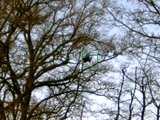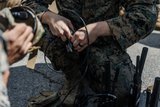EID to unveil new vehicle communication system at DSEI
The Portuguese company’s naval communications system is in service across more than a dozen countries. It has turned to its home nation for support in developing a new vehicle based C2 system.
Goodrich Corporation has been chosen by the Defense Advanced Research Project Agency (DARPA) to further develop its short wave infrared (SWIR) imaging technology for enhanced night vision capability.
Under DARPA’s Photon Counting Array (PCAR) program, Goodrich will develop materials and circuitry to allow its small, lightweight cameras to provide images under darker conditions than previously possible. Work will be performed at Goodrich’s ISR Systems business in Princeton, N.J.
The selection represents the third phase of the PCAR program; Goodrich completed the first two phases of PCAR from 2005 through mid-2009, and demonstrated the technology’s ability to produce imagers that delivered less “noise,” or random brightness variation, allowing better identification of people under darker night conditions.
Phase three of the development program will advance the technology’s ability to provide crisp images under no-moon conditions, providing greater human identification capabilities as well as increased situational awareness of terrain changes on the battlefield.
Ed Hart, vice president and general manager, Goodrich ISR Systems in Princeton, said “Our work in the PCAR program will further the capability of Goodrich’s SWIR cameras, giving our warfighters a great advantage on the battlefield. Going beyond detection to identification is an urgent need, and we look forward to developing and deploying this technology to many diverse platforms.”
SWIR technology detects reflected light at wavelengths that the human eye cannot see, in wavelength bands between visible and thermal cameras.
The Goodrich system is extremely small and lightweight; use of specialized indium gallium arsenide (InGaAs) materials and advanced circuitry allow it to run without cooling, whereas other imaging devices in the SWIR band need cumbersome power-hungry cooling systems.

The Portuguese company’s naval communications system is in service across more than a dozen countries. It has turned to its home nation for support in developing a new vehicle based C2 system.

The Vision4ce Deep Embedded Feature Tracking (DEFT) technology software is designed to process video and images by blending traditional computer vision with artificial intelligence (AI) algorithms to present actionable information from complex environments.

Persistent Systems has been cleared by National Security Agency (NSA) to transmit sensitive data on commercial networks. The devices are added to the NSA’s Commercial Solutions for Classified (CSfC) component list which also includes other companies’ products providing the same security.

The release of the UK’s Strategic Defence Review (SDR) has been long promised as mid-year. It is possible it could be as early as 2 June although the UK Ministry of Defence (MoD) continues to play its cards close to its chest.

Intelsat outlines how its multi-orbit SATCOM architecture is enhancing connectivity and resilience for special operations forces operating in degraded and contested environments.

Next-Generation Overhead Persistent Infrared (Next-Gen OPIR) satellites are intended to provide early warning of missile launches from any location worldwide and new ground stations will result in expanded coverage of critical missile warning.